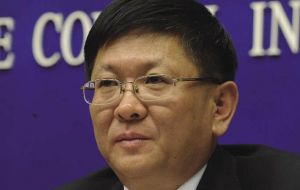MercoPress. South Atlantic News Agency
Fears of inflation and asset bubbles as China expands 11.9% in first quarter
 NBS spokesman Li Xiaochao said economic conditions remain “very complicated”
NBS spokesman Li Xiaochao said economic conditions remain “very complicated” China's economy expanded 11.9% year on year in the first quarter, indicating a solid recovery of the world's third largest economy, but also fanning concerns of asset bubbles, reports Xinhua.
The gross domestic product (GDP) in the first three months totalled 8.07 trillion Yuan (1.19 trillion U.S. dollars), the National Bureau of Statistics (NBS) announced Thursday. The rise was 5.7 percentage points higher than the same period last year, when it dropped to 6.2%, the lowest in a decade and higher than last year’s fourth quarter 10.7%.
”With the implementation of the stimulus package to combat the global economic downturn, the Chinese economy achieved a good start this year as the recovery momentum continues to consolidate, laying a solid foundation to meet the annual economic target (of 8% growth),“ NBS spokesman Li Xiaochao said at a press conference on Thursday.
”The 11.9% growth in the first quarter is largely a result of last year's low comparison base, and the government's stimulus,“ Li said.
The better-than-expected growth was largely driven by domestic demand, as retail sales surged 17.9% year on year in the first quarter, and fixed-asset investment rose 25.6%.
”The growth is strong, and above potential, but there are signs of overheating,” said Steven Green, head of research of Standard Chartered Bank (China).
He said with stimulus already partly ended, the key was whether the authorities could steer the economy on to a more sustainable growth path, or whether inflation or asset bubbles would occur in the second half of the year and trigger a bigger policy-induced slowdown in 2011
Despite the rosy figures, government remained cautious. Li Xiaochao said economic conditions remained “very complicated” with many difficulties still around.
The severe drought in southwest China and the rapid price increase of industrial products were challenges to achieving 8% annual growth he said.
“The world economy is gradually reheating in an unbalanced manner and faces uncertainty, as commodity prices have raised sharply and many countries have reported sovereign debt crises,” he said.
In reference to questions about the stimulus package, Li said the government would keep the economic policy stable and consistent as problems and difficulties remained.
“We will also make policy-setting more flexible and targeted according to developments, such as increasing cost pressures for many businesses,” he said.
After a cabinet meeting late Wednesday, the government said the proactive fiscal policy and relatively easy monetary policy would continue given the current “very complicated” economic conditions.
It also warned of real estate bubbles and other overheating industries, as housing prices were surging in cities, and the rising monetary and fiscal policy risks could not be ignored, said a statement issued after the meeting.
Following a government call to support economic recovery, China's banks lent a record 9.6 trillion yuan in new loans last year, which ignited fears of bad loans and asset bubbles.
With repeated government warnings of such risks since the end of last year, bank lending fell to 2.6 trillion yuan in the first quarter this year, 1.98 trillion yuan less than the corresponding period last year, the People's Bank of China, the central bank, said Monday.
China's consumer price index (CPI), the main gauge of inflation, saw a moderate rise of 2.4% year on year in March, and a decline of 0.7% month on month. The inflation rate was still below the government's upper target of 3% for this year, but staying within the limit might be “difficult and challenging,” said Li.
For the first quarter, the figure was up 2.2% from the same period last year.
“China's consumer prices are basically stable,” Li said, adding that the goal was still within reach with “concerted efforts and solid work”. He attributed the rise to the relatively low comparison basis of the first quarter of 2009 and the freezing winter, which brought dramatic rises in food prices.
Li also noted that other factors -- rising international commodity prices, domestic producer prices and industrial costs -- had also started to push up the CPI.
Zhu Baoliang, chief economist at the State Information Centre, said the government might find it difficult to achieve the 3% limit, but it could easily hold the inflation rate within 4% this year.
Consumer prices were growing at a moderate level, but there was still possibility of further inflation, due to excessive money supply, as well as the skyrocketing property prices and the prolonged drought in south China, Zhu said.
But as the government was set to gradually scale back money supply, inflation pressure would eventually ease, he said.
Jing Ulrich, chairman of China Equities and Commodities of JP Morgan Chase, agreed that inflation was expected to rise before peaking around mid-year.
Considering the upward trend in consumer prices and the recovery in exports, China's central bank might begin to raise interest rates in the second quarter to keep inflation in check, she said, adding J.P. Morgan Chase expected the PBOC to raise interest rates three times in 2010. She forecast that CPI growth would stand at 3.2 percent for 2010.




Top Comments
Disclaimer & comment rulesCommenting for this story is now closed.
If you have a Facebook account, become a fan and comment on our Facebook Page!